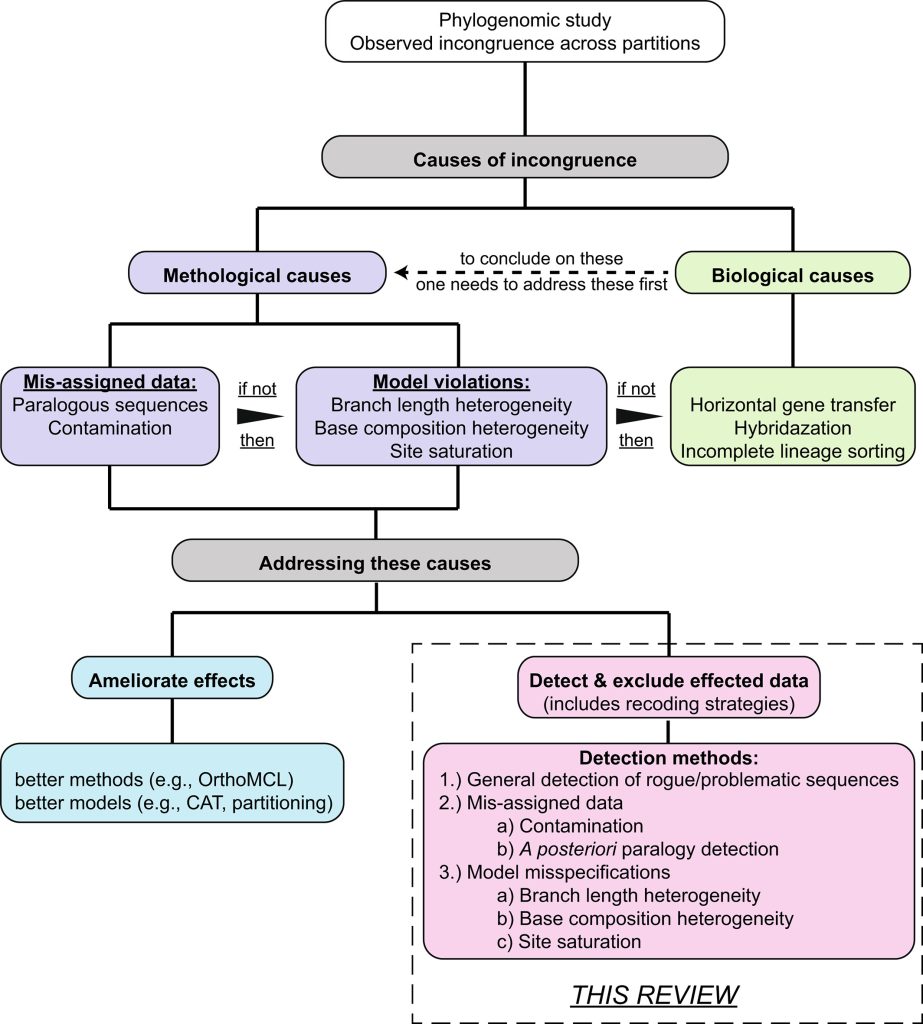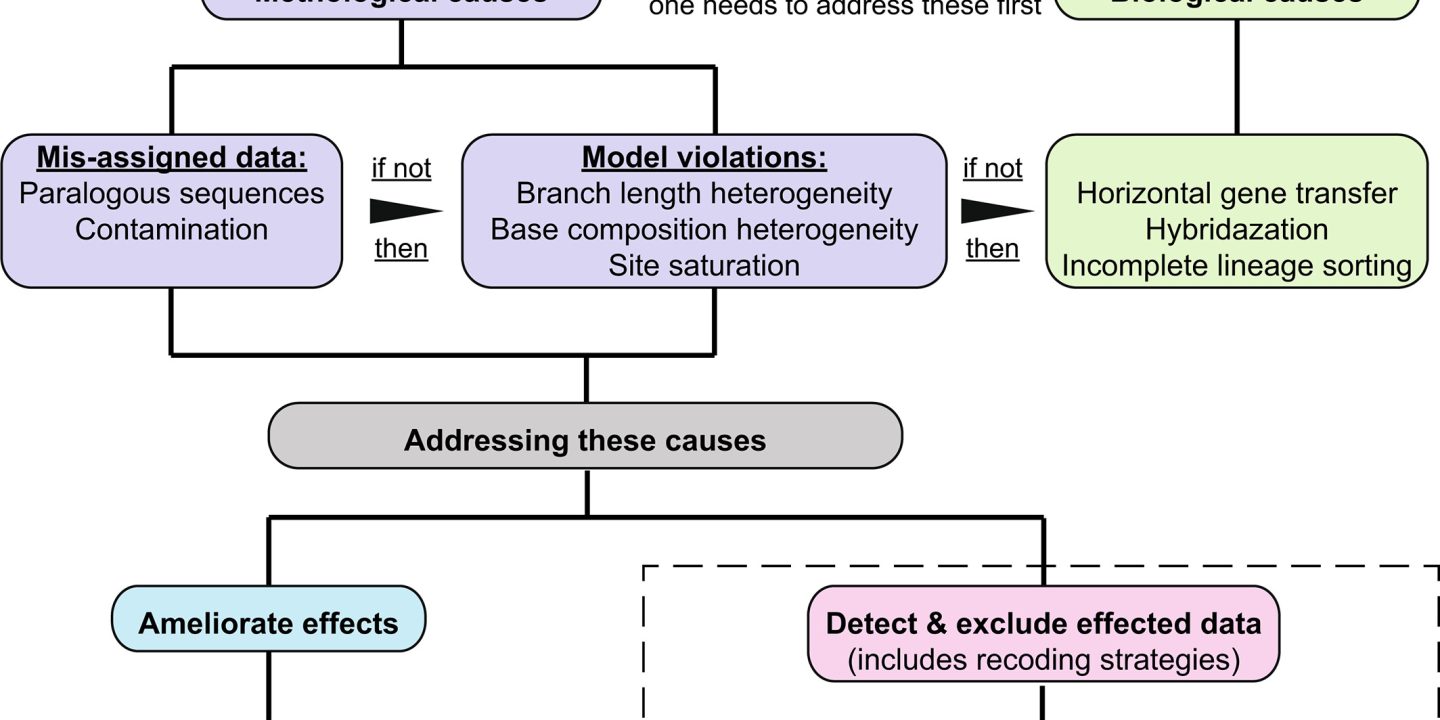A few weeks ago, the FEZ group produced another new paper, this time in Evolutionary Applications, titled “Identifying and addressing methodology incongruence in phylogenetics: a review”. It’s actually the first review I’ve ever been involved in writing and was a big change from my usual research work. As there isn’t anything new in here – it’s an introductory review for all the different phylogenetic tools you have available to you if you start running into problems with your data – I thought I’d try something a bit different with the blog too; and write the story of the publication. This review has changed massively from how it was originally conceived, and the story of the paper’s history is almost as entertaining as the review itself (I hope!)
When Alberto, Torsten and I first conceived of the review in August 2021, it was because we all realised that there were few truly user-friendly introductions to phylogenetic tools available in recent literature. There were brilliant textbooks, and incredible reviews internal to the field, but there was little to easily hand a new student to read first, and nothing we could find was focused directly on practical application, for use by a non-specialist biologist who just wanted to produce a phylogenetic tree for their paper. A lot of journals really like to see phylogenies alongside systematic studies of all sorts, so we thought this was an important gap in the literature and resolved to write a review. But that’s very broad – the field of phylogenetics is massive.
I’d never published a review before, and honestly hadn’t ever even considered it. I read a lot of reviews, particularly when I’m starting to research a new topic, but I’d always felt like the literature reviews I’d had to write during my degrees were a bit substandard, and probably deserved to just sit in a box on a shelf in my flat, denied the light of day. Unlike those reviews, which I’d mostly dashed off in a hurried fortnight, I soon discovered that I could write a review that I was proud of, it would just take time. A lot of time.
The first email in my inbox that I could find regarding the review was sent a month afterward the decision to write the review, in September. The first draft of the review was titled “Recent Progress in Countering Phylogenetic Artifacts”, and covered every potential issue a user might run into. It was a monster – by splurging every conceivable problem one could come up with onto the page, the three of us had created a comprehensive guide that sat somewhere between lecture course and textbook. It needed to be trimmed down. So, with this skeleton comprising far too many bones, we sat down and starting working out what could be done. And that meant reading lots of reviews to prepare our review.

Figure 1 of our review – our first draft actually encompassed all the bits in purple, green, blue and pink! The final scope of the review is just the pink. There was a lot of cutting involved.
Thankfully, at each turn, it seemed we weren’t the only ones in the field having just this idea. Every single time we looked away from the review to focus on research, it felt like really accessible reviews appeared! First, two brilliant papers on Biological Incongruence (truly biological reasons your dataset might look messy) and Systematic Error (where errors can occur in making phylogenetic analyses) were both published in 2021 by Mirarab and Kapli. Shortly after that, Lozano-Fernandez came out with an incredible review covering the design of a Phylogenetic study. These really helped us pick what to trim out and how to do it, which left us with a clear focus:
“If you’re new to the field, and you need a nuts and bolts look of what to actually do with the messy dataset you’ve been handed, how do you evaluate all these tools?”
That was what we originally set out to make, really, and trimming out the other areas helped us to focus down on making that as clear as possible. Certainly, when I’d started, it was the review I wished I could find. Phylogenetics is fun and fascinating, but the field is complex and frequently overwhelming. By going through each problem you might encounter, explaining what is causing it, and then explaining how it can be addressed, we hope to add some clarity to the learning process. I genuinely love this science – helping to piece together the shared history of life through the clues we have left over – but it can sometimes be inaccessible. We tackle branch length heterogeneity, site saturation, compositional heterogeneity and more – all really intimidating words that can mask what are really some very intuitive concepts. We ended up first submitting the review to Evolutionary Applications in December of 2022. A whole 16 months after we first started!
The one thing I really realised was that less is more. By making the review more focused, we were also able to explore key concepts in more detail and take the time to make sure the reader felt familiar with the barrage of information. Hopefully, we succeeded! It’s Open Access, so please do give it a read!
![]()

1 Comment on “Writing a Review: Introducing Your Field”